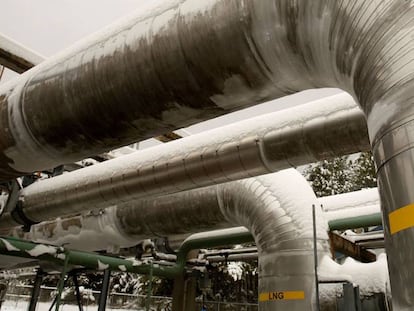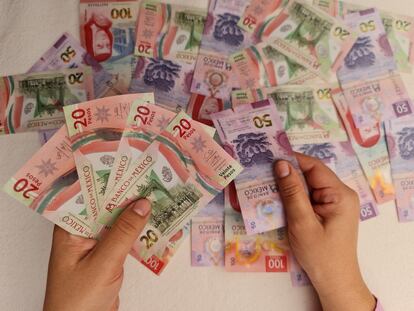Federal Reserve considers more aggressive interest rate hikes to curb inflation
Part of the market expects to see a rise of three quarters of a point, which would be the biggest increase since 1994


The Federal Reserve is looking for a way to curb inflation without causing a recession, but the path is getting narrower. The upward pressure on prices is relentless, and in May its annual rise marked a new 30-year high at 8.6%. Economists now think it very likely that the Fed will raise interest rates more aggressively than expected until recently.
The first step may be taken at the two-day meeting that began on Tuesday. In May, after raising rates by half a point, the biggest hike in 22 years, Federal Reserve Chairman Jerome Powell indicated that policymakers were planning two more half-point hikes to the benchmark interest rate in June and July. However, the market has begun to talk about a three-quarter point rise, which would be the highest since 1994, as the most likely result of the meeting (some analysts even speak of a whole point). For central banks, being predictable has become an asset. They try to anticipate what their movements are going to be to avoid scares and distortions in the markets, but this is not always possible.
In fact, the market has already adjusted its expectations. The sharp fall in the stock market is a clear symptom that combines fear of higher interest rates and lower growth. The dollar has strengthened and is trading again near the highs of the last 20 years against the main currencies, hurting the balance sheets of US multinationals. But the debt market is the place where there has really been a change of tack that has to do almost exclusively with interest rate expectations. The yield on three-year US Treasury bonds has soared, posting the biggest two-day rise since 1987, from 3% to 3.49%, according to data from Bloomberg.
In the money market, interest rate derivatives, which more accurately measure market expectations about policy rates, show that investors expect the Fed fund rate to be at 4% by the middle of next year, up from 0.75%-1% now. If the Fed was trying to avoid surprises, a rise of 0.75 points has almost ceased to be so, although there are also those who feel the central bank could still get away with half a point this week and delay the most aggressive rate rises to July or September.
Not even the Wall Street gurus are certain about the outcome of Wednesday’s meeting. For the chief economist for the United States at JP Morgan, the most likely outcome is a rise of 0.75 points, although there is the possibility that the Fed could amp this to one whole point. The head of global economic analysis at BoFA Securities, Ethan Harris, believes the rise will be 0.5 points, according to two reports sent to clients on Monday. However, Harris predicts that Fed Chair Powell will adopt a “whatever it takes” tone in the fight against inflation, in reference to the famous 2012 statement by the head of the European Central Bank at the time, Mario Draghi, to save the euro.
Recession risk
The problem is that what it takes may be a recession. Or, more accurately, what is required to curb inflation may be rate hikes that end up causing a recession. The rise in interest rates discourages companies and consumers from borrowing, as it makes loans more expensive, cools the real estate market and, in short, slows down the economy.
Morgan Stanley CEO James Gorman warns: “There was a legitimate recession risk. I used to think it was about 30%. It’s probably more like 50% now - it’s not 100%. It behooves you to be a little cautious.” Speaking at a corporate gathering on Monday, he said that “it was inevitable this inflation was not transitory, it was inevitable the Fed would have to move faster than they were projecting.” His colleague Jamie Dimon, from JP Morgan, had already warned weeks ago that he saw an economic hurricane coming.

The markets are showing another sign of this risk: the inverted rate curve. Normally, interest rates on debt are lower in the short term and higher in the long term, since the risk is greater in the long term. Putting interest rates at different terms on a graph, they usually show an upward curve. Sometimes, however, the curve turns around. That inverted curve, at least in some sense, is interpreted in the market as an indicator that a recession is coming (and that when inflation is controlled, rates will have to be lowered again).
Part of the price increases have to do with the reactivation of demand, but there are other reasons that are exogenous or the result of supply problems, and it is not clear that rate increases will be very effective in combating them. For example, gasoline prices are skyrocketing as a result of the rise in oil prices. The price of a gallon (3.78 liters) has exceeded $5 on average for the first time in history in the country as a whole, but in California it has reached around $8, prices never seen before.
The nightmare scenario would be stagflation, that is, stagnation with inflation. Rate hikes may bring the economy to a halt, but that may not be enough to achieve price stability. The political implications of the price increases are already being disastrous for the popularity of President Joe Biden, and for the expectations of the Democrats ahead of midterm elections in November, in which a little more than a third of the Senate and the entire House are up for renewal. If you add to that an economic slowdown, things could get even worse.
Tu suscripción se está usando en otro dispositivo
¿Quieres añadir otro usuario a tu suscripción?
Si continúas leyendo en este dispositivo, no se podrá leer en el otro.
FlechaTu suscripción se está usando en otro dispositivo y solo puedes acceder a EL PAÍS desde un dispositivo a la vez.
Si quieres compartir tu cuenta, cambia tu suscripción a la modalidad Premium, así podrás añadir otro usuario. Cada uno accederá con su propia cuenta de email, lo que os permitirá personalizar vuestra experiencia en EL PAÍS.
¿Tienes una suscripción de empresa? Accede aquí para contratar más cuentas.
En el caso de no saber quién está usando tu cuenta, te recomendamos cambiar tu contraseña aquí.
Si decides continuar compartiendo tu cuenta, este mensaje se mostrará en tu dispositivo y en el de la otra persona que está usando tu cuenta de forma indefinida, afectando a tu experiencia de lectura. Puedes consultar aquí los términos y condiciones de la suscripción digital.
More information
Últimas noticias
Most viewed
- Sinaloa Cartel war is taking its toll on Los Chapitos
- Oona Chaplin: ‘I told James Cameron that I was living in a treehouse and starting a permaculture project with a friend’
- Reinhard Genzel, Nobel laureate in physics: ‘One-minute videos will never give you the truth’
- Why the price of coffee has skyrocketed: from Brazilian plantations to specialty coffee houses
- Silver prices are going crazy: This is what’s fueling the rally










































